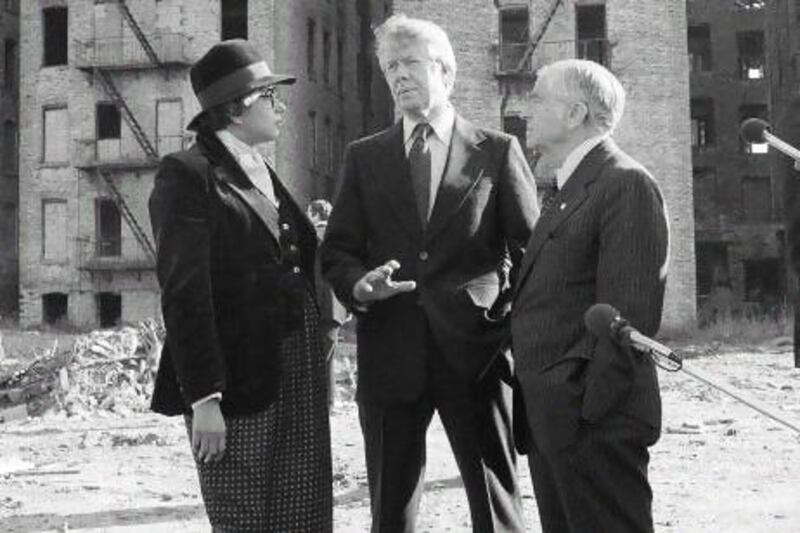On October 5, 1977, Jimmy Carter took a tour of the Third World by motorcade. Interrupting a visit to the United Nations headquarters in Manhattan, the US president crossed the Third Avenue Bridge and headed north to the Bronx, witnessing the devastation first-hand on Charlotte Street: "a block," according to a New York Times report, "on which all buildings on both sides had been demolished and the bricks had been bulldozed into heaps that in some places were eight feet high". Charlotte Street, and Carter's visit there, became a sort of shorthand for a city in precipitous decline, pummelled by white suburban flight, urban decay and poverty.
In 2003, a friend of mine who worked for New York City's Department of Housing Preservation and Development wangled spots for the two of us on a departmental walking tour. Our group was led past block after block of well-scrubbed family homes, framed by rows of planted trees and well-kept sidewalks. The overall effect was downright bucolic -positively suburban, if you go for that sort of thing. The place? It was the South Bronx - not just any street, either, but the very same burnt-out Charlotte Street that Carter had walked along 25 years earlier.
The story of the 21st century city, were you to be inclined to tell it, would be one of miraculous resuscitation. Battered by the cultural and social forces that drove the middle classes to the suburbs beginning in the 1940s, the metropolis was a denuded shell, starved of both innovation and resources. The danger - the likely outcome - was a steadily shrinking inner city. The future city was to be a less glamorous version of the movie Blade Runner, with society's outcasts on the ground floor, and the comfortable middle self-exiled to the higher levels of suburbia. It would be too presumptuous to say this dystopian future has failed to come to pass - the merest of glances at Detroit, for instance, pockmarked by empty lots and abandoned homes no one will ever live in again, would put rest to such an assumption - and yet, the decline of the city is the Holmesian dog that did not bark. The city has become not merely a relic of the outmoded past, but the fundamental building block of the future.
•••
In his new book City: A Guidebook for the Urban Age, P D Smith seeks to provide entrée to the city. Not any city in particular, but rather a patchwork city composed of every metropolis large and small, past and present, picking out the highlights and commonalities of urban living since the Sumerians constructed the first cities 5,000 years ago. City is a travel guide to an imaginary mashup of every city in history, offering a guided tour of urban features past and present - the central station, the department store and so on. "And don't worry about getting lost," Smith politely informs us. "Some say it's the only way really to experience a city."
City sifts through the layers of cities past piled one atop the other, such as the 18 levels of archaeological detritus at the site of Tell Abu Shahrain in Iraq. Even relatively new cities, such as Abu Dhabi, are constructed on the shards of the past, with today's skyscrapers built atop yesterday's fishing village. When cities first cropped up in the Mediterranean, their plans put temples at the centre of the city and religion became a prime mover of urbanism. Jerusalem was built, over millennia, around its holiest sites: the Jewish Temple, the Church of the Holy Sepulchre, the Dome of the Rock. When Pope Sixtus V designed a street plan for Rome in 1589, it was intended to move pilgrims rapidly and efficiently from one of the city's shrines and basilicas to the next. Town planning and spirituality were intertwined, with the tactile sensation of the city itself a quasi-religious experience. The religious city was succeeded by the industrial one, with railway stations and factories occupying the same positions of honour once held by houses of worship. And then modernism came along.
An art form like painting or literature, urbanism watched helplessly in the 20th century as the large, overarching ideologies collapsed under the weight of their own ambitions. The architect Le Corbusier had imagined rebuilding the city at a single stroke, wiping away the cluttered mass of houses and low-rise apartment buildings that defined most cities and replacing them with a visionary new scheme of skyscraper-esque towers surrounded by verdant parkland, open to all. "Unfortunately," Smith notes acidly, "when such plans were realised his utopian Towers in a Park quickly degenerated into Towers in a Car Park."
Architectural modernism was like Communism: an enticing idea with disastrous consequences. Smith's book, and Gary Hustwit's thought-provoking documentary Urbanised, both raise the example of Brasilia, perhaps the archetypal model of modernist urban planning. Brasilia was planned in the 1950s as a new capital for Brazil, built where previously there had been nothing but wilderness.
Lucio Costa, who designed Brasilia, was so slavishly devoted to the perfection of his city plan that he never bothered to visit the site where the future Brasilia would rise. The city's careful delineation of separate spheres for residential, governmental, and commercial zones made for a peculiarly lifeless city, with little of the workaday hubbub - lunch-hour errands, cafe-society - that comprise the buzz of city streets. Urbanised deftly sketches the yawning gap between modernist ambition and urban devastation, filming the iconic buildings designed for Brasilia by Oscar Niemeyer, and the charmless, treeless, highway-like roads that its residents have to hike along in order to walk from one modernist landmark to the next.
In the shadow of the modernist utopia's dismal collapse, a new generation of city planners and architects has revamped urbanism as a paradise of incrementalism. The small, careful approach tacks with the dismantling of utopian 20th century political and social ideologies. We no longer believe we can remake the world all at once, preferring to tackle one small problem at a time. Perhaps that is an improvement.
"Incoherent is good," Smith says, and the rule holds true for cities in general. The new urbanism operates on the principle that cities are not meant to cohere to a single overarching idea. New York needs its skyscrapers, but it also requires its bike paths; its temples of commerce must be conjoined with homely shops; its ranks of apartment buildings must adjoin abundant park space for all. The city is a fabulous jumble of mismatched parts.
Smith's fundamental point is that this incoherence is less of a divergence from the past than we might first think. Cities have been evolving for five millennia and many of the developments we think of as modern have a provenance deep in the historical past: by 3000BC, the world had its first metropolis, with Uruk (in present-day Iraq) containing more than 50,000 people. The city of Babylon spread out into suburbs 2,500 years ago. There was daily coach service from Clapham to the City of London beginning in 1690. The Circus Maximus in Rome had enough room for 150,000 spectators to take in a chariot race.
City is an engaging guide, but Smith seems less than entirely sure that American and European cities have successfully reversed what appeared to be a terminal decline. New York's miracle—from the famous headline "FORD TO CITY: DROP DEAD" to the era of the revitalised Times Square, a renewed building boom, and flourishing outer-borough development—lay partially in the return of the middle- and upper-middle classes to a city they had been thought to have permanently abandoned. This is so much part of the received narrative of the city's rebirth that we might forget that an overwhelming majority of newly minted urban dwellers in the 21st century are poor, living in favelas, shantytowns, and their equivalents across the world. This is a new challenge, and a deeply familiar one. In early 18th century London, there were 350 infant deaths for every 1,000 births, an urgent social problem not vanquished until the establishment of safe systems of clean water and sewerage in the mid-19th century. "The future is already here," Smith quotes novelist William Gibson. "It is just not evenly distributed."
•••
The key question for the 21st century city, of course, will be its environmental sustainability. Humans are increasingly coming to dwell in cities; where 1 in 10 people around the world lived in cities in 1900, half do today, and it is expected that three-quarters will by 2050.
"Urban territory is leased to each generation," Smith argues. "Residents and buildings are all temporary. What is permanent is the idea of the city." They are experiments, too, in the sense that they are constantly being tweaked, by politicians, entrepreneurs, homeowners, and sidewalk flaneurs. Downtown industrial buildings in Los Angeles are revamped as loft apartments, buses serve as rolling schools in Pune, India, and new roads and walkways transform a crumbling cliffside settlement in Caracas, Venezuela into a thriving neighbourhood.
The unifying thread of the new urbanism, as documented by the recent Cooper-Hewitt Museum show "Design for the Other 90%," is the makeshift nature of the solutions, which sound like what would result if cities dispatched a fleet of handymen and toolbelt-wearing dads to solve nagging social evils. The era of prosperity - of throwing a couple of billion dollars at a problem, and expecting it to go away—is over (except, perhaps, in China, which constructs new airports and subway systems like other cities fix potholes), and an era of creative austerity has been inaugurated in its place.
As David Owen compellingly argued in his 2009 book Green Metropolis, cities, for all their congestion and pollution, are far more sustainable than their rural or suburban counterparts. With city dwellers living in smaller spaces, in closer proximity to their neighbours, and depending less heavily on cars for their transportation needs, they are better positioned to make the necessary adjustments for the leaner, more efficient future that is on its way.
The conservative urbanist (a contradiction in terms, if there ever was one as loving cities means being a progressive, whatever your political beliefs) Edward Glaeser seconds Smith's notion of the city as solution to many of our most intractable social problems. The overly sanguine subtitle of his 2011 book, Triumph of the City, is "How Our Greatest Invention Makes Us Richer, Smarter, Greener, Healthier, and Happier." Triumph of the City, which was republished in paperback last month, is often too trusting of market solutions to urban problems, and Glaeser, writing for a popular audience, occasionally sounds like he is writing for terminally uninformed readers.
Its surface flaws notwithstanding, Glaeser's book is also a pragmatic celebration of the city, and a blueprint for their continued growth. Dubai, in Glaeser's estimation, is a prime example of the new urban planning, treating cities as regional hubs whose appeal stretches beyond national borders. "Just as Hong Kong thrived by being an oasis of economic freedom next to once highly restrictive Communist China, Dubai succeeds by offering better economic institutions than its neighbours." Glaeser pleads with policymakers to reverse some of the constraints—better schools, cheaper housing and so on —that have traditionally favoured the suburbs over the city. "Too many countries have stacked the deck against urban areas, despite the fact that those areas are a - if not the - source of national strength," he argues. "Cities don't need handouts, but they need a level playing field."
Perhaps the most essential factor in cities' favour is their ability to get people out of their own cars and into alternative modes of transport. For wealthy countries to begin reversing their dependence on oil, people must begin picking trains, trams, taxis and buses over private cars. This can only be possible on a large enough scale to matter in dense urban areas. Moscow has three billion subway riders per year. For the sake of the planet's health, we better hope that Guangzhou and Bangalore follow suit in short order.
As a conservative urbanist, Glaeser cannily argues for exposing cities to the power of the free market. Those words are enough to strike fear into the heart of many after 2008's financial crisis, but this is not the metropolis of Goldman Sachsville. Government, he argues, should not interfere with the natural ebb and flow of population, resources, and skilled workers to and from cities. In the US, the Obama administration should no more attempt to prop up a failing city, like Detroit, than the administration of John Adams, in 1800, should have expended resources on ensuring that Gloucester, Massachusetts—current population: 28,789—remained one of the 20 largest cities in the United States.
Moreover, well-meaning preservationists have managed to do grievous harm by seeking to protect whole swathes of the city from the wrecking ball. Without a historical conscience, cities are prone to appalling lapses in judgement—think of the destruction of Penn Station in New York or London's Euston Station. But in order to thrive, cities must grow denser, and taller, packing ever-more people into the urban core. Cities like San Francisco and Paris that artificially limit building heights, while undoubtedly aesthetically pleasing, push home prices up and exile the middle and working classes to the suburbs, or to cities, like Phoenix in Arizona, where lax regulation translates into endless sprawl.
So what will the city of the future look like? Smith guesses that it will be medium-sized cities, such as Abu Dhabi, whose Plan 2030, emphasising public transit and walkability, who will become the face of the urban green renaissance, transforming the city into a machine for sustainable living. Plan 2030 aims to transform Abu Dhabi into a truly Arab city, while also taking on distinctly international urbanist values like care for the natural environment and restrained, intelligent growth.
If so, it may bear some resemblance to Masdar City, designed by the British starchitect Sir Norman Foster. Masdar is a harbinger of the forthcoming melding of technology and ecology, mobilising cutting-edge design in the name of safeguarding the environment, and Smith sounds downright giddy at the possibility: "Residents and visitors must park their cars outside Masdar City and most of the transport in the city will be provided by a futuristic fleet of driverless, pod-shaped electric cars - the personal rapid transit system." In writing this, Smith unwittingly renders Masdar City as the City of Bumper Cars, more an amusement park ride or somewhere to visit for a few hours than a place to call home, but perhaps this is what the future will look like: the metropolis as curated urban space, a ride we take alone in the company of strangers.
Along with China, the Emirates are where the high-rise future of urbanism is first coming into view. Kate Ascher, in her new book The Heights: Anatomy of a Skyscraper describes the "streamlined capsules" of the Burj Khalifa's elevators, its supermarket, Armani hotel, cigar club, and 122nd-floor restaurant, and the "wind trackers" keeping residents informed of outdoor conditions, and we know we are catching a glimpse of the supertall, mixed-use future once imagined by the likes of Le Corbusier and Frank Lloyd Wright.
"What a ruin it will make!" the science-fiction author H G Wells exclaimed on first catching sight of Manhattan. Anyone who has ever loved a city - walked its streets, suffered its traumas, argued about its future -knows precisely how Wells felt. And yet, if we are to avoid our flesh-and-blood cities from becoming jagged ruins of crumbling stone and denuded brick, we would be best served to follow the prescriptions of this motley assemblage of theorists, advocates and flaneurs. "The city is our most remarkable invention," argues Smith. He is absolutely right. But in order to survive, we must continually reinvent the city. If we do not, ruins will be all that will be left.
Saul Austerlitz is a writer based in New York.





